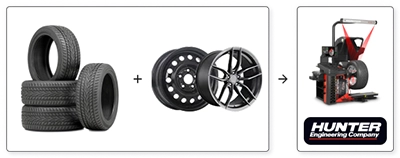Why Reduce the Size of Your Wheels in Winter?

For several years now, we have observed a trend among car manufacturers: larger and larger wheels are being fitted to new vehicles. Take the BMW X7, for example, which can come equipped with wheels up to 22 inches in size from the factory. Full-size trucks and even some more affordable SUVs are also adopting large wheels for aesthetic reasons. However, these large wheels pose several problems in winter. Fortunately, there is a simple solution: reduce the size of your wheels in winter.
Problems with Large Wheels in Winter
1. Higher Cost of Tire Replacement
The first issue is the cost of replacing the tires. Low-profile tires are more expensive. It may seem counterintuitive, but the larger the wheel size, the more the tire's structure needs to be reinforced to absorb shocks. As a result, it is not uncommon to find that 22-inch tires can cost up to twice as much as 18-inch tires. Additionally, some shops charge extra fees for mounting larger tires since the necessary equipment is more sophisticated and expensive.
2. Increased Fuel Consumption
Another drawback of larger wheels is the increase in fuel consumption. A larger rim means that the weight is distributed further from the center of the wheel. This requires more energy to propel the vehicle, which results in slightly higher fuel consumption. Even though the impact may seem minimal, a few tenths of a liter per 100 kilometers can accumulate and represent a significant cost over a year.
3. Increased Risk of Damage
Finally, the risk of damage is higher with large wheels in winter. Roads are often damaged by the freeze-thaw cycle, leading to potholes and cracks. Large rims combined with low-profile tires are particularly vulnerable to these conditions, increasing the risk of damage.
The Solution: Reduce the Size of Your Wheels in Winter
The solution to these problems is simple and effective: use smaller wheels for winter. Here's why:
Savings on Tire Costs
By opting for smaller wheels, you significantly reduce the cost of purchasing winter tires. Tires in smaller sizes, such as 17 or 18 inches, are cheaper than larger sizes like 20 or 22 inches. Additionally, some shops charge less for mounting smaller tires, allowing you to save on seasonal changes.
Reduction in Fuel Consumption
Smaller wheels contribute to better fuel economy. Being lighter, they require less energy to propel the vehicle, which can lead to a slight reduction in fuel consumption, beneficial in the long term.
Lower Risk of Damage
Higher-profile tires, paired with smaller wheels, offer better protection against potholes and road debris. Their ability to absorb shocks helps prevent rim damage, reducing the risk of costly repairs.
Wheel Options for Winter
When considering reducing the size of your wheels for winter, several options are available:
Steel Wheels
Steel wheels are a popular option for winter. They are often less expensive than alloy wheels and offer increased durability to withstand winter conditions. Although less aesthetically pleasing, they are practical and economical.
Alloy Wheels
If appearance is important to you, alloy wheels are an excellent alternative. They are more expensive than steel wheels but allow you to maintain the style of your vehicle while benefiting from the advantages of smaller wheels in winter.
Conclusion
Reducing the size of your wheels in winter is a smart decision to improve safety, reduce costs, and minimize the risk of damage. At PMCtire.com, we offer a wide range of wheels and tires suitable for all types of vehicles for winter. Whether you opt for steel wheels or alloy wheels, our experts are here to guide you in your choice and ensure you are ready to face winter conditions with peace of mind.


